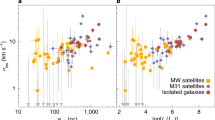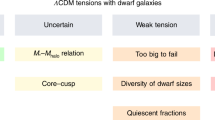Abstract
The kinematics of dwarf galaxies are strongly influenced by dark matter down to small galactocentric radii. So they are good candidates to investigate the nature of Dark Matter. In the present work we have carried out mass modeling of a number of recently observed dwarf galaxies Swaters et al. in Astron. Astrophys. 493:871, 2009. We have used a Navarro-Frenk-White (NFW) halo, Freeman disc along with a gaseous disc for modeling the observed rotation curves of those dwarf galaxies. For comparison we also used a Burkert halo, Freeman disc and gaseous disc. For both the scenario we have performed Kolmogorov–Smirnov (KS) test between the observed and predicted rotational velocity profiles. The tests are rejected for NFW halo almost in 50 per cent cases but they are accepted almost for all cases for Burkert halo, preferring a Burkert halo model generally for dwarf galaxies. The above results reveal a constant density core of dark matter (DM) in the halos of dwarf galaxies compared to a cuspy nature of NFW halo and a possible challenge to \(\Lambda\)-CDM scenario for the nature of dark matter in most of the dwarf galaxies.


Similar content being viewed by others
References
Bento, M.C., Bertolami, O., Rosenfeld, R., Teodoro, L.: Phys. Rev. D 62, 041302 (2000)
Binney, J.J., Gerhard, O.E., Silk, J.: Mon. Not. R. Astron. Soc. 321, 471 (2001)
Burkert, A.: Astrophys. J. 447, L25 (1995)
Burkert, A., Silk, J.: Astrophys. J. 488, L55 (1997)
Burkert, A.: Astrophys. J. 534, L143 (2000)
Boylan-Kolchin, M., Bullock, J.S., Kaplinghat, M.: Mon. Not. R. Astron. Soc. 422, 1203 (2012)
Boylan-Kolchin, M., Bullock, J.S., Kaplinghat, M.: Mon. Not. R. Astron. Soc. 415, L40 (2011)
Carlson, E.D., Machacek, M.E., Hall, L.J.: Astrophys. J. 398, 43 (1992)
Cole, D.R., Dehnen, W., Wilkinson, M.I.: Mon. Not. R. Astron. Soc. 416, 1118 (2011)
Dalcanton, J.J., Bernstein, R.A.: In: Combes, F., Mamom, G.A., Charmandaris, V. (eds.) XVth IAP Meeting Dynamics of Galaxies: from the Early Universe to the Present, ASP Conf. Ser. Vol. 197, p. 161. Astron. Soc. Pac., San Francisco (2000)
Del Popolo, A.: Astron. Rep. 51, 169 (2007)
Del Popolo, A.: Astrophys. J. 698, 2093 (2009)
Del Popolo, A., Kroupa, P.: Astron. Astrophys. 502, 733 (2009)
Del Popolo, A.: Mon. Not. R. Astron. Soc. 424, 38 (2012a)
Del Popolo, A.: Mon. Not. R. Astron. Soc. 419, 971 (2012b)
Del Popolo, A.: AIP Conf. Proc. 1548, 2 (2013)
Del Popolo, A.: J. Cosmol. Astropart. Phys. 7, 19 (2014a)
Del Popolo, A.: Int. J. Mod. Phys. D 23(3), 1430005 (2014b)
Del Popolo, A., Hiotelis, N.: J. Cosmol. Astropart. Phys. 1, 47 (2014)
El-Zant, A., Shlosman, I., Hoffman, Y.: Astrophys. J. 560, 636 (2001)
El-Zant, A.A., et al.: Astrophys. J. Lett. 607, L75 (2004)
Firmani, C., D’Onghia, E., Chincarini, G., Hernańdez, X., Avila-Reese, V.: Mon. Not. R. Astron. Soc. 321, 713 (2001)
Flores, R., Primack, J.R.: Astrophys. J. 427, L1 (1994)
Freeman, K.C.: Astrophys. J. 160, 811 (1970)
Frusciante, N., Salucci, P., Vernieri z, D., Cannon, J.M., Elson, E.C.: Mon. Not. R. Astron. Soc. 426, 751 (2012)
Fukushige, T., Makino, J.: Astrophys. J. 477, L9 (1997)
Ghigna, S., Moore, B., Governato, F., Lake, G., Quinn, T., Stadel, J.: Mon. Not. R. Astron. Soc. 300, 146 (1998)
Ghosh, M., Basu, B., Bhattacharyya, T.: Astrophys. Space Sci. 152, 131 (1989)
Governato, F., et al.: Nature 463, 203 (2010)
Hogan, C.J., Dalcanton, J.J.: Phys. Rev. D 62, 063511 (2000)
Hu, W., Peebles, P.J.E.: Astrophys. J. 528, 61 (2000)
Inoue, S., Saitoh, T.R.: Mon. Not. R. Astron. Soc. 418, 2527 (2011)
Kamionkowski, M., Liddle, A.R.: Phys. Rev. Lett. 84, 4525 (2000)
Kauffmann, G., White, S.D.M., Guiderdoni, B.: Mon. Not. R. Astron. Soc. 264, 201 (1993)
Klypin, A.A., Kravtsov, A.V., Valenzuela, O., Prada, F.: Astrophys. J. 522, 82 (1999)
Kolmogorov, A.: In: Foundations of the Theory of Probability, 2nd edn. Chelsea, New York (1956)
Komatsu, E., Smith, K.M., Dunkley, J., et al.: Astrophys. J. Suppl. Ser. 192, 18 (2011)
Lang, K.R.: Astrophysical Formulae, p. 226. Springer, New York (1978)
Mashchenko, S., Couchman, H.M.P., Sills, A.: Astrophys. J. 639, 633 (2006)
Mac Low, M.-M., Ferrara, A.: Astrophys. J. 513, 142 (1999)
Martizzi, D., Teyssier, R., Moore, B., Wentz, T.: Mon. Not. R. Astron. Soc. 422, 3081 (2012)
McGaugh, S.S., de Blok, W.J.G.: Astrophys. J. 499, 41 (1998)
Moore, B.: Nature 370, 629 (1994)
Moore, B., Ghigna, S., Governato, F., Lake, G., Quinn, T., Stadel, J., Tozzi, P.: Astrophys. J. 524, L19 (1999)
Navarro, J.F., et al.: Mon. Not. R. Astron. Soc. 402, 21 (2010)
Navarro, J.F., Eke, V.R., Frenk, C.S.: Mon. Not. R. Astron. Soc. 283, 72 (1996)
Newman, A.B., Treu, T., Ellis, R.S., Sand, D.J.: Astrophys. J. 765, 25 (2013a)
Newman, A.B., Treu, T., Ellis, R.S., Sand, D.J., Nipoti, C., Richard, J., Jullo, E.: Astrophys. J. 765, 24 (2013b)
Oman, K.A., et al.: arXiv:1504.01437 (2015)
Peñarrubia, J., Pontzen, A., Walker, M.G., Koposov, S.E.: Astrophys. J. 759, L42 (2012)
Peebles, P.J.E.: Astrophys. J. 534, L127 (2000)
Peebles, P.J.E., Vilenkin, A.: Phys. Rev. D 60, 103506 (1999)
Romano-Diaz, E., Shlosman, I., Heller, C., Hoffman, Y.: Astrophys. J. 702, 1250 (2009)
Romano-Diaz, E., Shlosman, I., Hoffman, Y., Heller, C.: Astrophys. J. Lett. 685, L105 (2008)
Salucci, P., Yegorova, I.A., Drory, N.: Mon. Not. R. Astron. Soc. 388, 159 (2008)
Sommer-Larsen, J., Dolgov, A.: Astrophys. J. 551, 608 (2001)
Stadel, J., et al.: Mon. Not. R. Astron. Soc. 398, L21 (2009)
Strickland, D.K., Stevens, I.R.: Mon. Not. R. Astron. Soc. 314, 511 (2000)
Swaters, R.A., Sancisi, R., van Albada, T.S., van der Hulst, J.F.: Astron. Astrophys. 493, 871 (2009)
Watson, G.N.: In: A Treatise on the Theory of Bessel Functions, 2nd edn. Cambridge University Press, Cambridge (1931)
White, M., Croft, R.A.: Astrophys. J. 539, 497 (2000)
White, S.D.M., Springel, V.: In: Weiss, A., Hill, Abel T.G. V (eds.) The First Stars, p. 327. Springer, Berlin (2000)
Yoshida, N., Springel, V., White, S.D.M., Tormen, G.: Astrophys. J. 535, L103 (2000)
Zolotov, A., Brooks, A.M., Willman, B., et al.: Astrophys. J. 761, 71 (2012)
Acknowledgements
The authors are very grateful for the valuable points suggested by referee to improve the quality of the manuscript to a great extent.
Author information
Authors and Affiliations
Corresponding author
Appendix: Kolmogorov–Smirnov one sample test
Appendix: Kolmogorov–Smirnov one sample test
The test for goodness of fit usually involves examining a random sample from some unknown distribution in order to test the null hypothesis that the unknown distribution function is in fact a known, specified function. We usually use Kolmogorov–Smirnov test to check the normality assumption in Analysis of Variance. However it can be used for other continuous distributions also. A random sample \(X_{1},X_{2}, \ldots, X_{n}\) is drawn from some population and is compared with \(F^{*}(x)\) in some way to see if it is reasonable to say that \(F^{*}(x)\) is the true distribution function of the random sample.
One logical way of comparing the random sample with \(F^{*}(x)\) is by means of the empirical distribution function \(S(x)\). The empirical distribution function \(S(x)\) is a function of \(x\), which equals the fraction of \(X_{i}\)s that are less than or equal to \(x\) for each \(x\). The empirical distribution function \(S(x)\) is useful as an estimator of \(F(x)\), the unknown distribution function of the \(X_{i}\)s.
We can compare the empirical distribution function \(S(x)\) with hypothesized distribution function \(F^{*}(x)\) to see if there is good agreement. One of the simplest measures is the largest distance between the two functions \(S(x)\) and \(F^{*}(x)\), measured in a vertical direction. This is the statistic suggested by Kolmogorov (1956). Let the test statistic \(T\) be the greatest (denoted by “sup” for supremum) vertical distance between \(S(x)\) and \(F^{*}(x)\). In symbols we say
For testing
against
If \(T\) exceeds the 1-\(\alpha\) quantile then we reject \(H_{0}\) at the level of significance \(\alpha\). The approximate \(p\)-value can be found by interpolation.
Rights and permissions
About this article
Cite this article
Karmakar, P., Chattopadhyay, T. & Chattopadhyay, A.K. Study of the nature of dark matter in halos of dwarf galaxies. Astrophys Space Sci 358, 46 (2015). https://doi.org/10.1007/s10509-015-2444-y
Received:
Accepted:
Published:
DOI: https://doi.org/10.1007/s10509-015-2444-y




